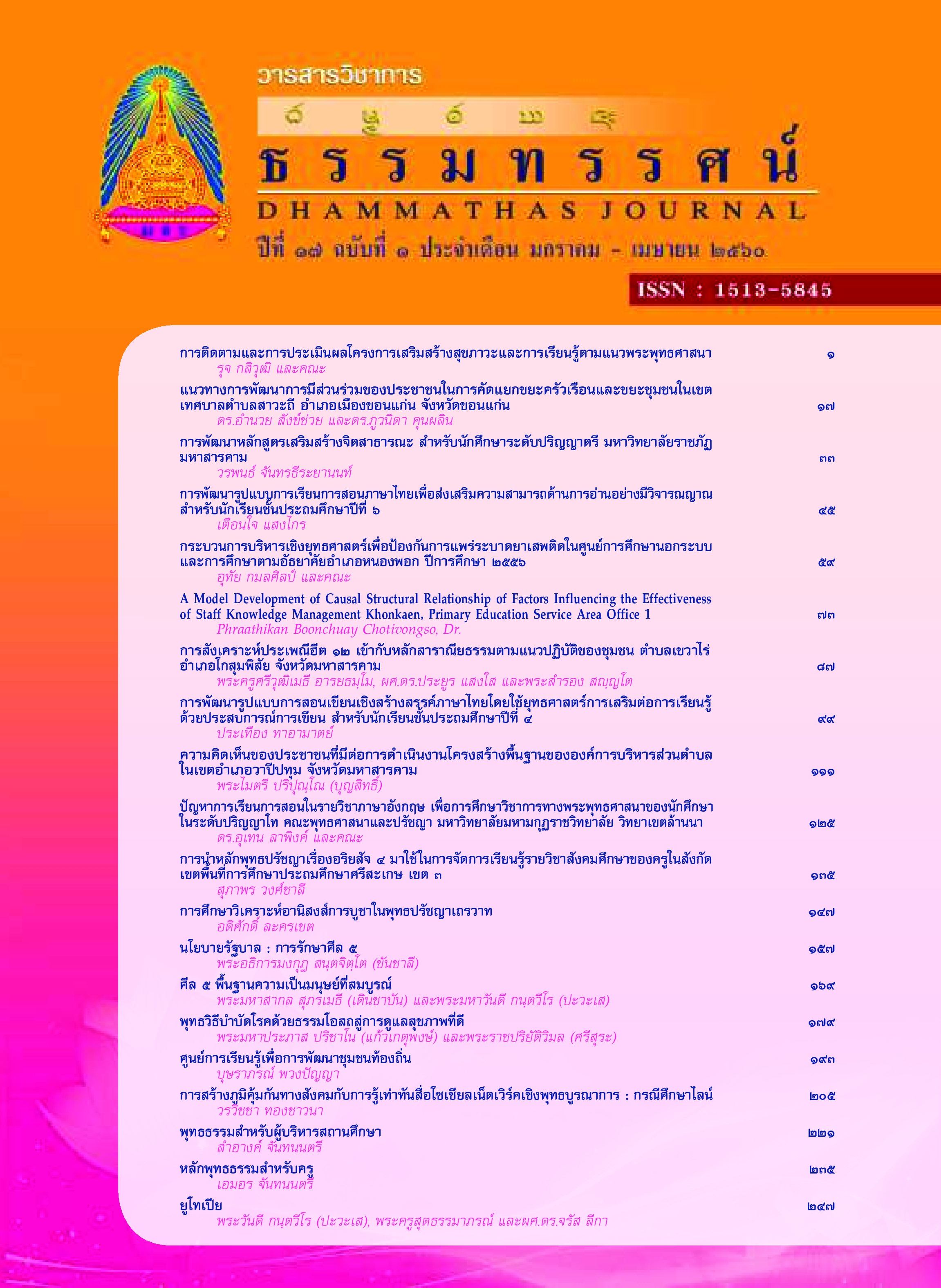การพัฒนารูปแบบการเรียนการสอนภาษาไทยเพื่อส่งเสริมความสามารถด้านการอ่านอย่างมีวิจารณญาณ สำหรับนักเรียนชั้นประถมศึกษาปีที่ ๖
Main Article Content
Abstract
บทคัดย่อ
การวิจัยครั้งนี้ มีวัตถุประสงค์เพื่อ ๑) พัฒนารูปแบบการเรียนการสอนภาษาไทยเพื่อส่งเสริมความสามารถด้านการอ่านอย่างมีวิจารณญาณ สำหรับนักเรียนชั้นประถมศึกษาปีที่ ๖ ๒) ศึกษาผลการใช้รูปแบบการเรียนการสอนภาษาไทยเพื่อส่งเสริมความสามารถด้านการอ่านอย่างมีวิจารณญาณ สำหรับนักเรียนชั้นประถมศึกษาปีที่ ๖ การวิจัยแบ่งออกเป็น ๒ ระยะคือ การวิจัยระยะที่ ๑ การพัฒนารูปแบบการเรียนการสอนเพื่อส่งเสริมความสามารถในการอ่านอย่างมีวิจารณญาณ กลุ่มสาระการเรียนรู้ภาษาไทย สำหรับชั้นประถมศึกษาปีที่ ๖แบ่งเป็น ๒ ขั้นตอนคือ ขั้นที่ ๑ การศึกษาบริบทสภาพปัจจุบันปัญหาความต้องการด้านการจัดการเรียนการสอน ขั้นที่ ๒ การสังเคราะห์ร่างต้นแบบรูปแบบการสอนครูผู้สอนกลุ่มสาระการเรียนรู้ภาษาไทย จำนวน ๑๒ โรง และนักเรียนชั้นประถมศึกษาปีที่ ๖ ที่กำลังศึกษาปีการศึกษา ๒๕๕๗ ภาคเรียนที่ ๑ ปีการศึกษา ๒๕๕๗ ในศูนย์พัฒนาคุณภาพการศึกษาเมืองท่า จำนวน ๑๑๖ คน และการวิจัยระยะที่ ๒ การพัฒนาประสิทธิภาพของรูปแบบการเรียนการสอน เพื่อส่งเสริมความสามารถในการอ่านอย่างมีวิจารณญาณ ด้วยกระบวนการ SQ5R และยุทธศาสตร์ เมตาคอกนิชัน กลุ่มเป้าหมายคือ นักเรียนชั้นประถมศึกษาปีที่ ๖ ที่กำลังศึกษาปีการศึกษา ๒๕๕๗ ภาคเรียนที่ ๒ โรงเรียนในศูนย์พัฒนาคุณภาพการศึกษาเมืองท่า สังกัดสำนักงานเขตพื้นที่การประถมศึกษามหาสารคาม เขต ๑ จากโรงเรียน ๔ โรงได้กลุ่มตัวอย่าง จำนวน ๔๗ คน ซึ่งได้มาโดยการเลือกแบบเจาะจง เครื่องมือได้แก่แผนการจัดการเรียนรู้ แบบฝึกทักษะการอ่านอย่างมีวิจารณญาณ แบบวัดความสามารถในการอ่านอย่างมีวิจารณญาณ แบบทดสอบวัดผลสัมฤทธิ์ทางการเรียน สถิติที่ใช้ในการวิจัย ได้แก่ ค่าร้อยละ ค่าเฉลี่ย ค่าเบี่ยงเบนมาตรฐาน และค่า t-test (Dependent Sample)
ผลการวิจัยพบว่า
๑. การพัฒนารูปแบบการเรียนการสอนเพื่อส่งเสริมความสามารถในการอ่านอย่างมีวิจารณญาณ กลุ่มสาระการเรียนรู้ภาษาไทย สำหรับนักเรียนชั้นประถมศึกษาปีที่ ๖ ประกอบด้วย ๖ องค์ประกอบ คือ ๑) การจำแนกข้อเท็จจริงจากข้อคิดเห็น ๒) การตีความการบอกโครงเรื่องหรือสรุปใจความจากเรื่องที่อ่าน ๓) การตระหนักถึงทัศนะและจุดมุ่งหมายของผู้เขียน ๔) การวิเคราะห์เรื่องที่อ่าน ๕) การตัดสินความน่าเชื่อถือของแหล่งข้อมูล และ ๖) การประเมินค่าของเรื่องที่อ่าน
๒. ผลการใช้รูปแบบการเรียนการสอนภาษาไทยเพื่อส่งเสริมความสามารถด้านการอ่านอย่างมีวิจารณญาณ สำหรับนักเรียนชั้นประถมศึกษาปีที่ ๖
๒.๑ ประสิทธิภาพของรูปแบบการเรียนการสอนเพื่อส่งเสริมความสามารถในการอ่านอย่างมีวิจารณญาณ กลุ่มสาระการเรียนรู้ภาษาไทย สำหรับนักเรียนชั้นประถมศึกษาปีที่ ๖ (E1 / E2) เท่ากับ ๘๑.๔๘/๘๐.๖๓ ดังนั้นรูปแบบการเรียนการสอนเพื่อส่งเสริม ความสามารถในการอ่านอย่างมีวิจารณญาณ ด้วยกระบวนการ SQ5R มีประสิทธิภาพเท่ากับ ๘๑.๔๘/๘๐.๖๓ ซึ่งสูงกว่าเกณฑ์ที่กำหนด
๒.๒ นักเรียนชั้นประถมศึกษาปีที่ ๖ มีคะแนนความสามารถในการอ่านอย่างมีวิจารณญาณหลังเรียนสูงกว่าก่อนเรียนอย่างมีนัยสำคัญทางสถิติที่ระดับ .๐๑
Abstract
The research aimed to 1) develop a Thai instructional model for critical reading ability promotion for 6th grade students, 2) study the results of implementing the model for critical reading ability promotion for 6th grade students. The research was divided into 3 phases. Phase 1 dealt with the development of the model for critical reading ability promotion in the Thai learning strand for 6th grade students. It was divided into 2 steps. Step 1 dealt with the study of the context, the current state, problems and needs relating to the instruction. Step 2 dealt with the synthesis of the draft instructional model for Thai learning strand teachers in 12 schools and 116 6th grade students who were studying in the 1st semester of the academic year 2014 in Muangta educational quality development center. Phase 2 dealt with the development of the efficiency of
the instructional model for critical reading ability promotion, using the SQ5R process and
metacognitive strategies. The sample group comprised 47 Thai learning strand teachers and 6th grade students in the 2nd semester of the academic year 2014 in 4 schools under Muangta educational quality development center, MahaSarakham office of primary education service area 1, obtained through purposive sampling. The instruments consisted of learning organization plans, critical reading drills, a critical reading ability test, and a learning achievement test. The statistics employed were percentage, the mean, standard deviation, and t-test (dependent samples).
The results are as follows:
1. The development of the instructional model for critical reading ability promotion in the Thai learning strand for 6th grade students consisted of 6 components: 1) differentiation of facts and opinions, 2) interpretation, giving the outline of the story or summarizing the story read, 3) realization of the author’s view and goals, 4) analysis of the story read, 5) judging the reliability of the source of data, and 6) evaluation of the story read.
2. The results of implementing the Thai instructional model for critical reading ability promotion for 6th grade students are as follows:
2.1 The efficiency of the instructional model for critical reading ability promotion in the Thai learning strand for 6th grade students (E1 / E2) was 81.48/80.63. Therefore, the model for critical reading ability promotion with the SQ5R process had the efficiency of 81.48/80.63 which was higher than the preset criterion.
2.2 The 6th grade students had their scores of critical reading ability after learning higher than before learning with statistical significance at the level of .01.
